Causes and Consequences of Gender Bias in Health and Education
VerifiedAdded on 2023/01/16
|8
|1655
|50
AI Summary
This document discusses the causes and consequences of gender bias in health and education. It explores how cultural beliefs and limited opportunities affect women's empowerment in these sectors.
Contribute Materials
Your contribution can guide someone’s learning journey. Share your
documents today.

Economic Development
Students Name
Institution
Students Name
Institution
Secure Best Marks with AI Grader
Need help grading? Try our AI Grader for instant feedback on your assignments.
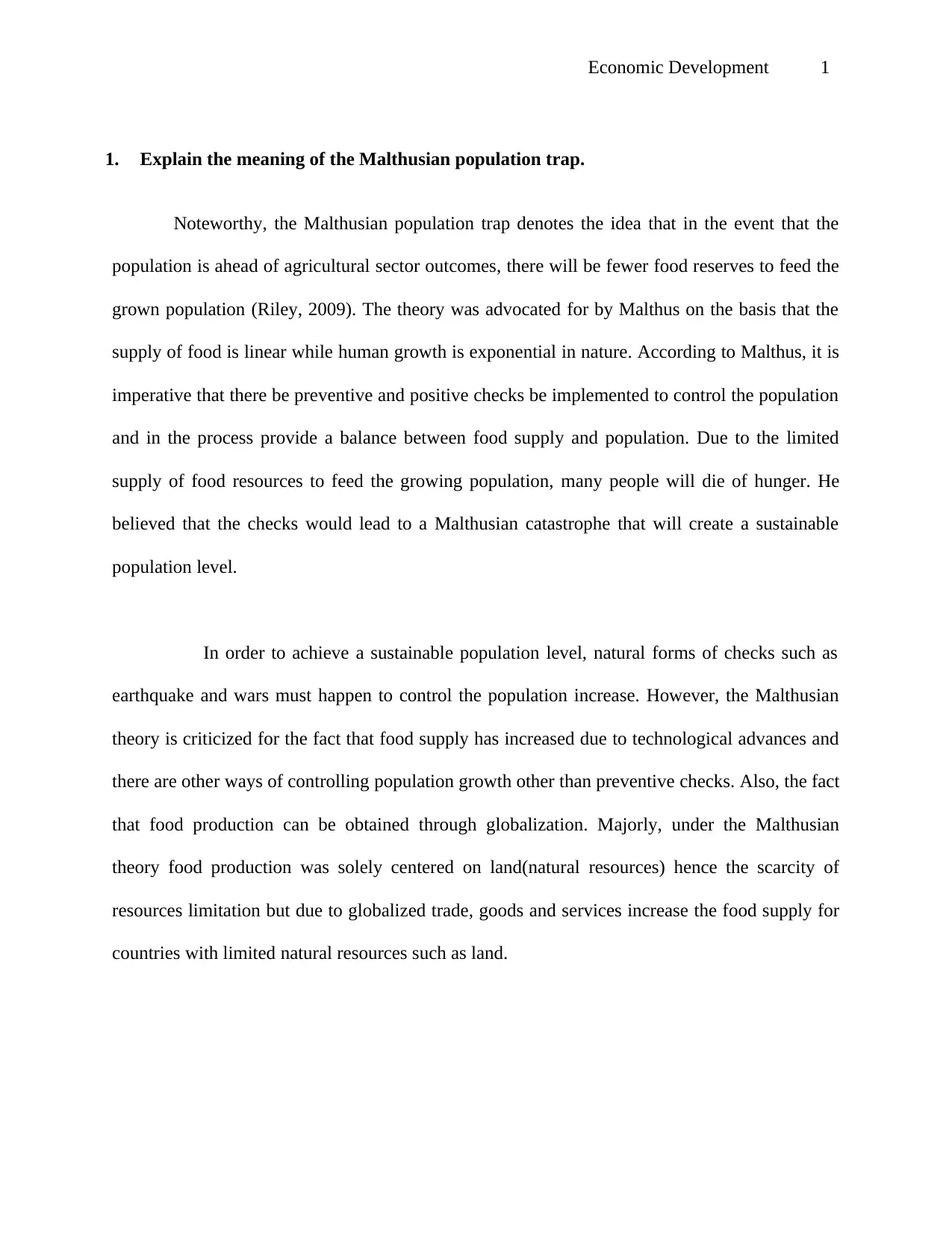
Economic Development 1
1. Explain the meaning of the Malthusian population trap.
Noteworthy, the Malthusian population trap denotes the idea that in the event that the
population is ahead of agricultural sector outcomes, there will be fewer food reserves to feed the
grown population (Riley, 2009). The theory was advocated for by Malthus on the basis that the
supply of food is linear while human growth is exponential in nature. According to Malthus, it is
imperative that there be preventive and positive checks be implemented to control the population
and in the process provide a balance between food supply and population. Due to the limited
supply of food resources to feed the growing population, many people will die of hunger. He
believed that the checks would lead to a Malthusian catastrophe that will create a sustainable
population level.
In order to achieve a sustainable population level, natural forms of checks such as
earthquake and wars must happen to control the population increase. However, the Malthusian
theory is criticized for the fact that food supply has increased due to technological advances and
there are other ways of controlling population growth other than preventive checks. Also, the fact
that food production can be obtained through globalization. Majorly, under the Malthusian
theory food production was solely centered on land(natural resources) hence the scarcity of
resources limitation but due to globalized trade, goods and services increase the food supply for
countries with limited natural resources such as land.
1. Explain the meaning of the Malthusian population trap.
Noteworthy, the Malthusian population trap denotes the idea that in the event that the
population is ahead of agricultural sector outcomes, there will be fewer food reserves to feed the
grown population (Riley, 2009). The theory was advocated for by Malthus on the basis that the
supply of food is linear while human growth is exponential in nature. According to Malthus, it is
imperative that there be preventive and positive checks be implemented to control the population
and in the process provide a balance between food supply and population. Due to the limited
supply of food resources to feed the growing population, many people will die of hunger. He
believed that the checks would lead to a Malthusian catastrophe that will create a sustainable
population level.
In order to achieve a sustainable population level, natural forms of checks such as
earthquake and wars must happen to control the population increase. However, the Malthusian
theory is criticized for the fact that food supply has increased due to technological advances and
there are other ways of controlling population growth other than preventive checks. Also, the fact
that food production can be obtained through globalization. Majorly, under the Malthusian
theory food production was solely centered on land(natural resources) hence the scarcity of
resources limitation but due to globalized trade, goods and services increase the food supply for
countries with limited natural resources such as land.
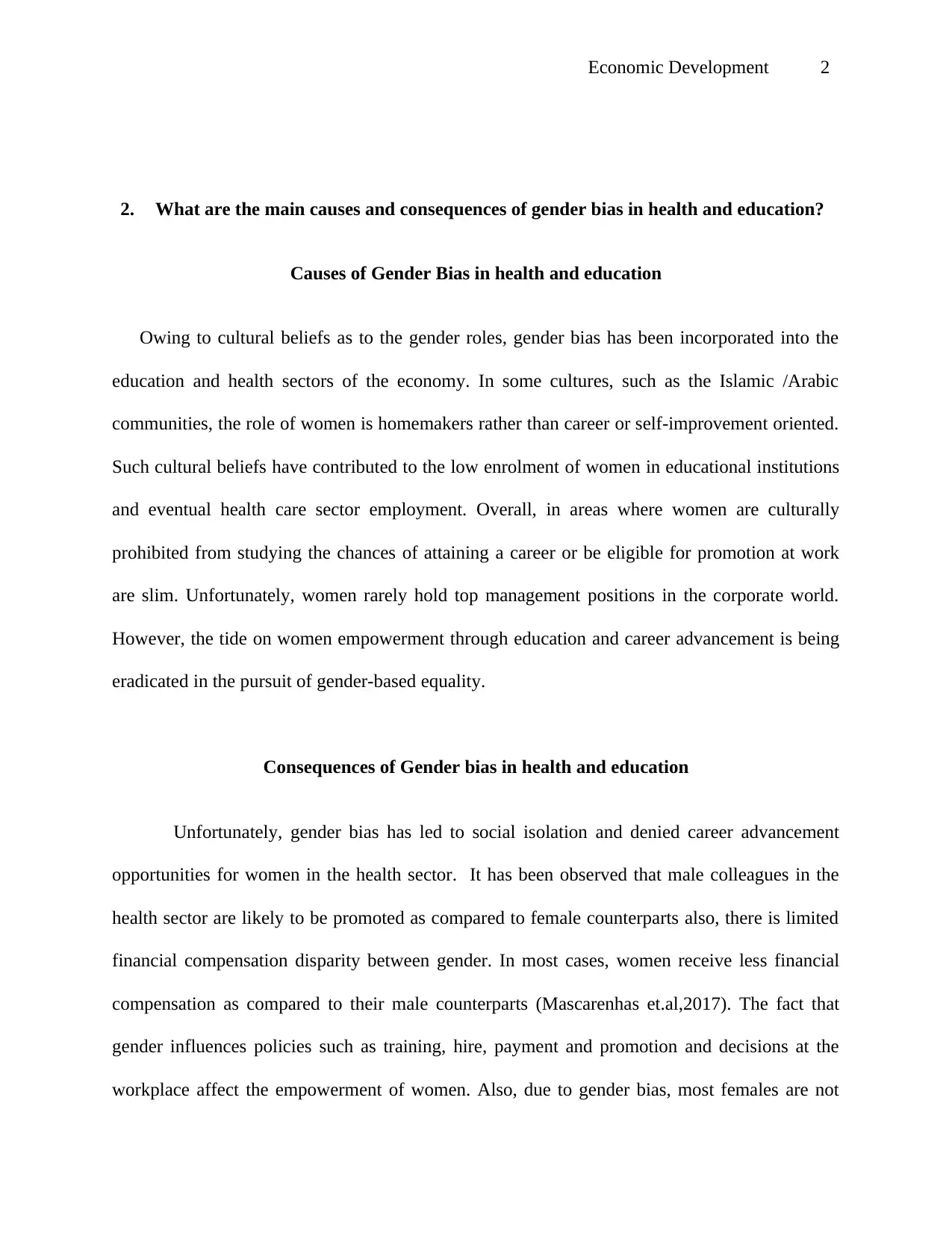
Economic Development 2
2. What are the main causes and consequences of gender bias in health and education?
Causes of Gender Bias in health and education
Owing to cultural beliefs as to the gender roles, gender bias has been incorporated into the
education and health sectors of the economy. In some cultures, such as the Islamic /Arabic
communities, the role of women is homemakers rather than career or self-improvement oriented.
Such cultural beliefs have contributed to the low enrolment of women in educational institutions
and eventual health care sector employment. Overall, in areas where women are culturally
prohibited from studying the chances of attaining a career or be eligible for promotion at work
are slim. Unfortunately, women rarely hold top management positions in the corporate world.
However, the tide on women empowerment through education and career advancement is being
eradicated in the pursuit of gender-based equality.
Consequences of Gender bias in health and education
Unfortunately, gender bias has led to social isolation and denied career advancement
opportunities for women in the health sector. It has been observed that male colleagues in the
health sector are likely to be promoted as compared to female counterparts also, there is limited
financial compensation disparity between gender. In most cases, women receive less financial
compensation as compared to their male counterparts (Mascarenhas et.al,2017). The fact that
gender influences policies such as training, hire, payment and promotion and decisions at the
workplace affect the empowerment of women. Also, due to gender bias, most females are not
2. What are the main causes and consequences of gender bias in health and education?
Causes of Gender Bias in health and education
Owing to cultural beliefs as to the gender roles, gender bias has been incorporated into the
education and health sectors of the economy. In some cultures, such as the Islamic /Arabic
communities, the role of women is homemakers rather than career or self-improvement oriented.
Such cultural beliefs have contributed to the low enrolment of women in educational institutions
and eventual health care sector employment. Overall, in areas where women are culturally
prohibited from studying the chances of attaining a career or be eligible for promotion at work
are slim. Unfortunately, women rarely hold top management positions in the corporate world.
However, the tide on women empowerment through education and career advancement is being
eradicated in the pursuit of gender-based equality.
Consequences of Gender bias in health and education
Unfortunately, gender bias has led to social isolation and denied career advancement
opportunities for women in the health sector. It has been observed that male colleagues in the
health sector are likely to be promoted as compared to female counterparts also, there is limited
financial compensation disparity between gender. In most cases, women receive less financial
compensation as compared to their male counterparts (Mascarenhas et.al,2017). The fact that
gender influences policies such as training, hire, payment and promotion and decisions at the
workplace affect the empowerment of women. Also, due to gender bias, most females are not
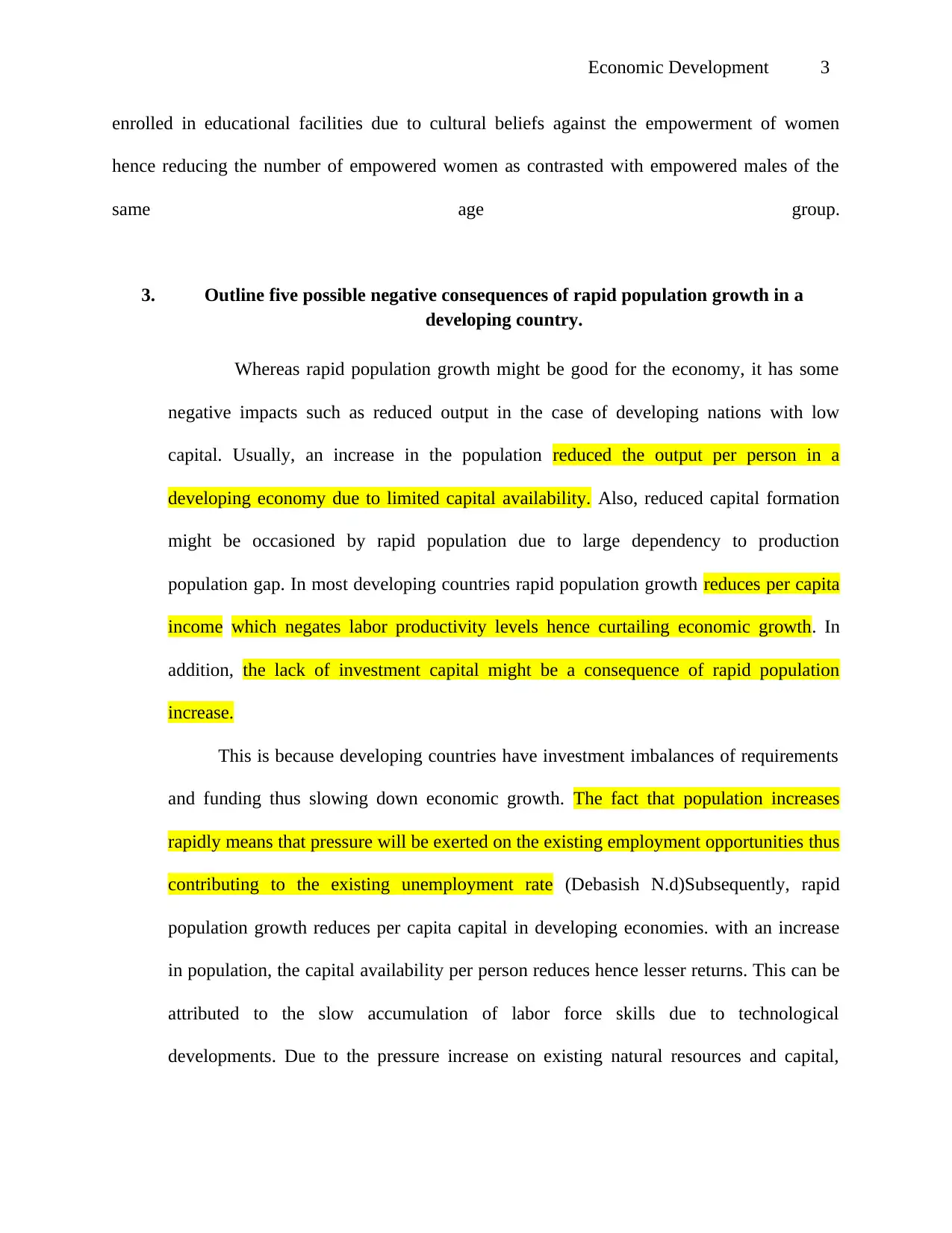
Economic Development 3
enrolled in educational facilities due to cultural beliefs against the empowerment of women
hence reducing the number of empowered women as contrasted with empowered males of the
same age group.
3. Outline five possible negative consequences of rapid population growth in a
developing country.
Whereas rapid population growth might be good for the economy, it has some
negative impacts such as reduced output in the case of developing nations with low
capital. Usually, an increase in the population reduced the output per person in a
developing economy due to limited capital availability. Also, reduced capital formation
might be occasioned by rapid population due to large dependency to production
population gap. In most developing countries rapid population growth reduces per capita
income which negates labor productivity levels hence curtailing economic growth. In
addition, the lack of investment capital might be a consequence of rapid population
increase.
This is because developing countries have investment imbalances of requirements
and funding thus slowing down economic growth. The fact that population increases
rapidly means that pressure will be exerted on the existing employment opportunities thus
contributing to the existing unemployment rate (Debasish N.d)Subsequently, rapid
population growth reduces per capita capital in developing economies. with an increase
in population, the capital availability per person reduces hence lesser returns. This can be
attributed to the slow accumulation of labor force skills due to technological
developments. Due to the pressure increase on existing natural resources and capital,
enrolled in educational facilities due to cultural beliefs against the empowerment of women
hence reducing the number of empowered women as contrasted with empowered males of the
same age group.
3. Outline five possible negative consequences of rapid population growth in a
developing country.
Whereas rapid population growth might be good for the economy, it has some
negative impacts such as reduced output in the case of developing nations with low
capital. Usually, an increase in the population reduced the output per person in a
developing economy due to limited capital availability. Also, reduced capital formation
might be occasioned by rapid population due to large dependency to production
population gap. In most developing countries rapid population growth reduces per capita
income which negates labor productivity levels hence curtailing economic growth. In
addition, the lack of investment capital might be a consequence of rapid population
increase.
This is because developing countries have investment imbalances of requirements
and funding thus slowing down economic growth. The fact that population increases
rapidly means that pressure will be exerted on the existing employment opportunities thus
contributing to the existing unemployment rate (Debasish N.d)Subsequently, rapid
population growth reduces per capita capital in developing economies. with an increase
in population, the capital availability per person reduces hence lesser returns. This can be
attributed to the slow accumulation of labor force skills due to technological
developments. Due to the pressure increase on existing natural resources and capital,
Secure Best Marks with AI Grader
Need help grading? Try our AI Grader for instant feedback on your assignments.
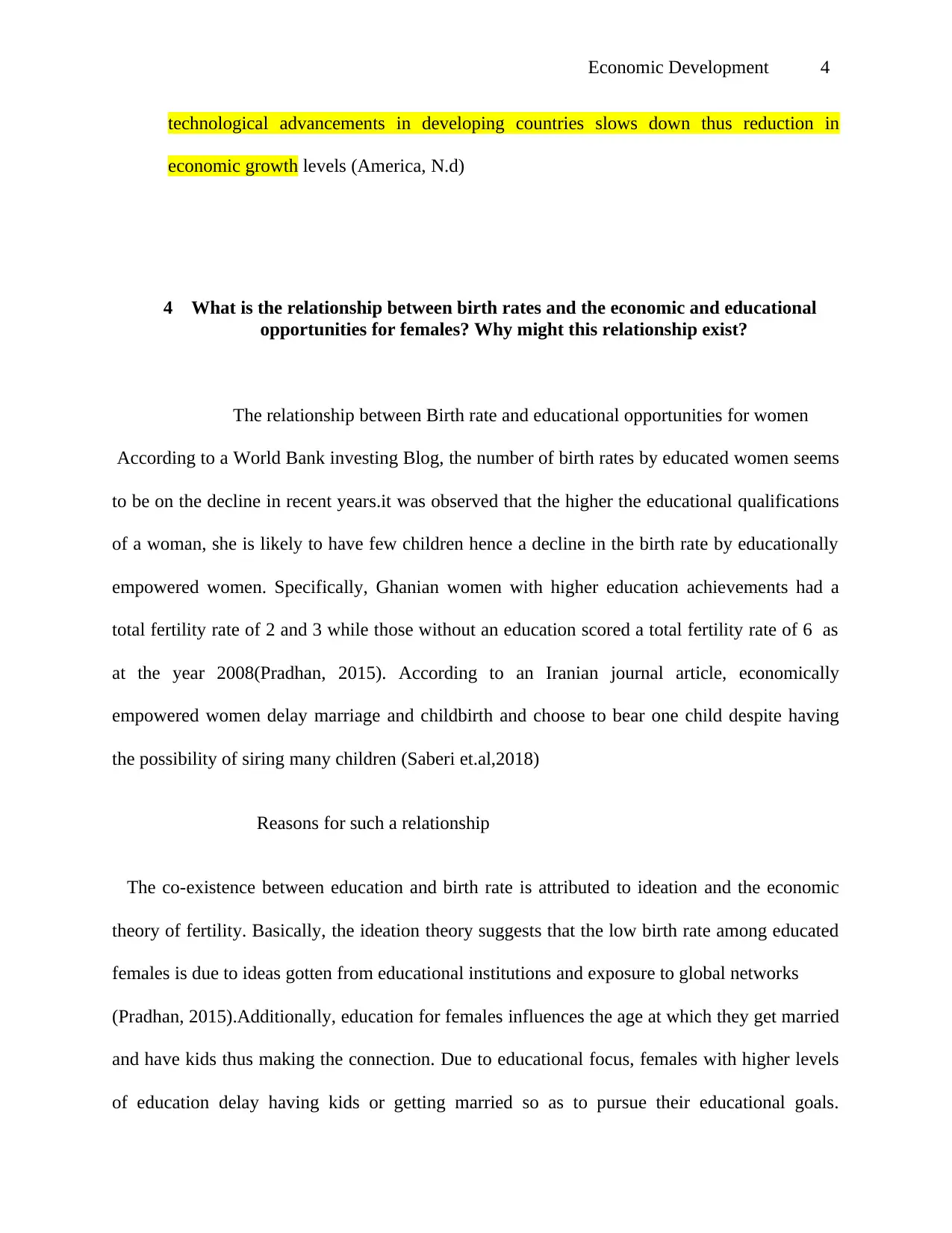
Economic Development 4
technological advancements in developing countries slows down thus reduction in
economic growth levels (America, N.d)
4 What is the relationship between birth rates and the economic and educational
opportunities for females? Why might this relationship exist?
The relationship between Birth rate and educational opportunities for women
According to a World Bank investing Blog, the number of birth rates by educated women seems
to be on the decline in recent years.it was observed that the higher the educational qualifications
of a woman, she is likely to have few children hence a decline in the birth rate by educationally
empowered women. Specifically, Ghanian women with higher education achievements had a
total fertility rate of 2 and 3 while those without an education scored a total fertility rate of 6 as
at the year 2008(Pradhan, 2015). According to an Iranian journal article, economically
empowered women delay marriage and childbirth and choose to bear one child despite having
the possibility of siring many children (Saberi et.al,2018)
Reasons for such a relationship
The co-existence between education and birth rate is attributed to ideation and the economic
theory of fertility. Basically, the ideation theory suggests that the low birth rate among educated
females is due to ideas gotten from educational institutions and exposure to global networks
(Pradhan, 2015).Additionally, education for females influences the age at which they get married
and have kids thus making the connection. Due to educational focus, females with higher levels
of education delay having kids or getting married so as to pursue their educational goals.
technological advancements in developing countries slows down thus reduction in
economic growth levels (America, N.d)
4 What is the relationship between birth rates and the economic and educational
opportunities for females? Why might this relationship exist?
The relationship between Birth rate and educational opportunities for women
According to a World Bank investing Blog, the number of birth rates by educated women seems
to be on the decline in recent years.it was observed that the higher the educational qualifications
of a woman, she is likely to have few children hence a decline in the birth rate by educationally
empowered women. Specifically, Ghanian women with higher education achievements had a
total fertility rate of 2 and 3 while those without an education scored a total fertility rate of 6 as
at the year 2008(Pradhan, 2015). According to an Iranian journal article, economically
empowered women delay marriage and childbirth and choose to bear one child despite having
the possibility of siring many children (Saberi et.al,2018)
Reasons for such a relationship
The co-existence between education and birth rate is attributed to ideation and the economic
theory of fertility. Basically, the ideation theory suggests that the low birth rate among educated
females is due to ideas gotten from educational institutions and exposure to global networks
(Pradhan, 2015).Additionally, education for females influences the age at which they get married
and have kids thus making the connection. Due to educational focus, females with higher levels
of education delay having kids or getting married so as to pursue their educational goals.
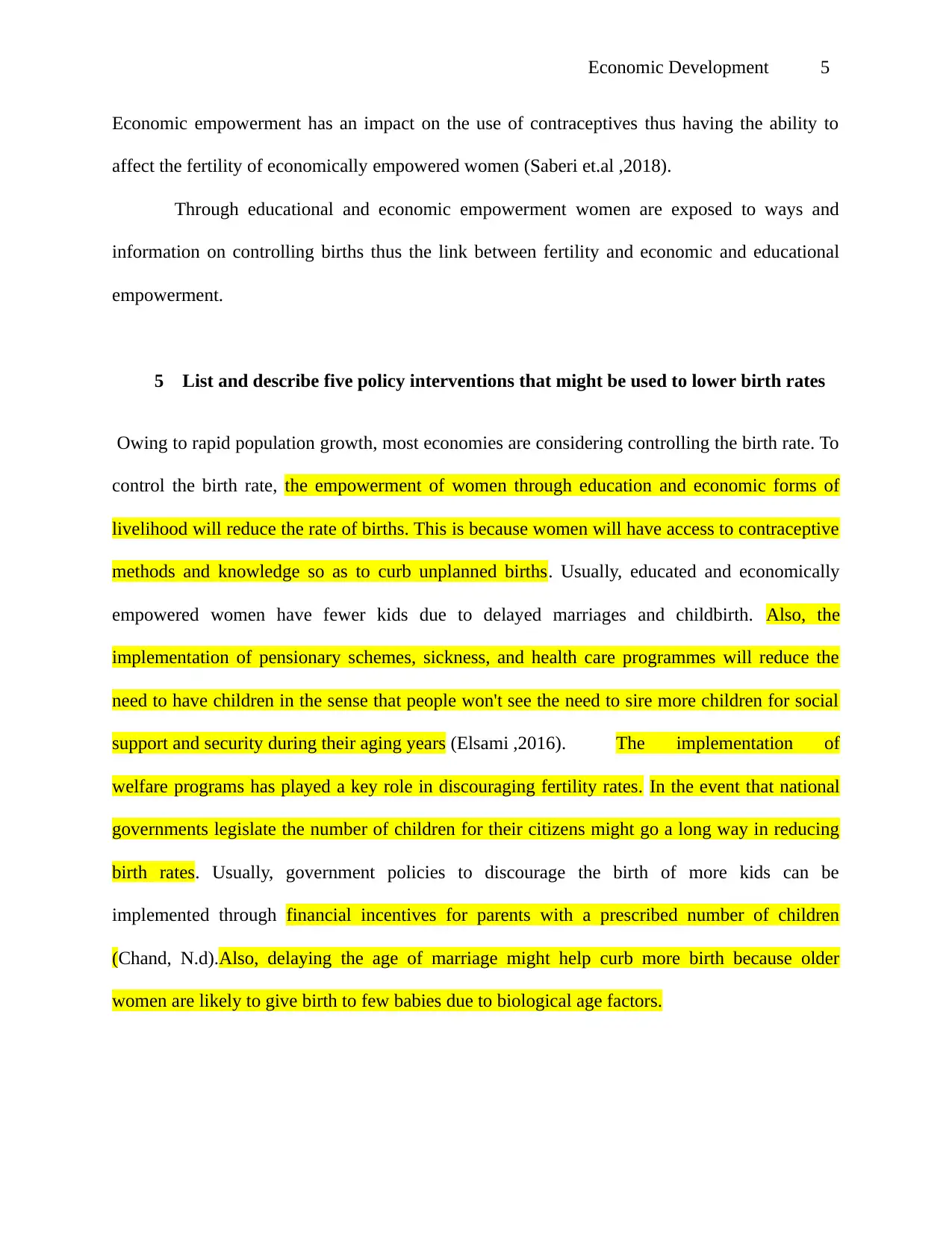
Economic Development 5
Economic empowerment has an impact on the use of contraceptives thus having the ability to
affect the fertility of economically empowered women (Saberi et.al ,2018).
Through educational and economic empowerment women are exposed to ways and
information on controlling births thus the link between fertility and economic and educational
empowerment.
5 List and describe five policy interventions that might be used to lower birth rates
Owing to rapid population growth, most economies are considering controlling the birth rate. To
control the birth rate, the empowerment of women through education and economic forms of
livelihood will reduce the rate of births. This is because women will have access to contraceptive
methods and knowledge so as to curb unplanned births. Usually, educated and economically
empowered women have fewer kids due to delayed marriages and childbirth. Also, the
implementation of pensionary schemes, sickness, and health care programmes will reduce the
need to have children in the sense that people won't see the need to sire more children for social
support and security during their aging years (Elsami ,2016). The implementation of
welfare programs has played a key role in discouraging fertility rates. In the event that national
governments legislate the number of children for their citizens might go a long way in reducing
birth rates. Usually, government policies to discourage the birth of more kids can be
implemented through financial incentives for parents with a prescribed number of children
(Chand, N.d).Also, delaying the age of marriage might help curb more birth because older
women are likely to give birth to few babies due to biological age factors.
Economic empowerment has an impact on the use of contraceptives thus having the ability to
affect the fertility of economically empowered women (Saberi et.al ,2018).
Through educational and economic empowerment women are exposed to ways and
information on controlling births thus the link between fertility and economic and educational
empowerment.
5 List and describe five policy interventions that might be used to lower birth rates
Owing to rapid population growth, most economies are considering controlling the birth rate. To
control the birth rate, the empowerment of women through education and economic forms of
livelihood will reduce the rate of births. This is because women will have access to contraceptive
methods and knowledge so as to curb unplanned births. Usually, educated and economically
empowered women have fewer kids due to delayed marriages and childbirth. Also, the
implementation of pensionary schemes, sickness, and health care programmes will reduce the
need to have children in the sense that people won't see the need to sire more children for social
support and security during their aging years (Elsami ,2016). The implementation of
welfare programs has played a key role in discouraging fertility rates. In the event that national
governments legislate the number of children for their citizens might go a long way in reducing
birth rates. Usually, government policies to discourage the birth of more kids can be
implemented through financial incentives for parents with a prescribed number of children
(Chand, N.d).Also, delaying the age of marriage might help curb more birth because older
women are likely to give birth to few babies due to biological age factors.

Economic Development 6
References
America, L..(N. d).The consequences of rapid population growth .Retrieved from
https://openknowledge.worldbank.org/bitstream/handle/10986/5967/9780195204605_ch0
5.pdf?sequence=6
Chand, S. (N .d).Different ways of reducing the birth Rate. Retrieved from
http://www.yourarticlelibrary.com/population/different-ways-for-reducing-the-birth-rate/
32892
Debasish. (N .d).14 Major Negative effects of population Explosion. Retrieved from
http://www.economicsdiscussion.net/population-explosion/14-major-negative-effects-of-
population-explosion/4461
Eslami, M. (2016). Decreasing Total fertility rate in developing countries. Journal for family
and reproductive health. Retrieved from
https://www.ncbi.nlm.nih.gov/pmc/articles/PMC5440814/
Mascarenhas,A.,Moore,E.J.,Tricco,C.A.,Hamid,J,Daly,C,Bain,j.,Jassemi,S,Kiran,T,Baxter,N &
Straus, E.S.(2017). Perceptions and experiences of a gender gap at a Canadian research
institute and potential strategies to mitigate this gap: a sequential mixed-methods study.
References
America, L..(N. d).The consequences of rapid population growth .Retrieved from
https://openknowledge.worldbank.org/bitstream/handle/10986/5967/9780195204605_ch0
5.pdf?sequence=6
Chand, S. (N .d).Different ways of reducing the birth Rate. Retrieved from
http://www.yourarticlelibrary.com/population/different-ways-for-reducing-the-birth-rate/
32892
Debasish. (N .d).14 Major Negative effects of population Explosion. Retrieved from
http://www.economicsdiscussion.net/population-explosion/14-major-negative-effects-of-
population-explosion/4461
Eslami, M. (2016). Decreasing Total fertility rate in developing countries. Journal for family
and reproductive health. Retrieved from
https://www.ncbi.nlm.nih.gov/pmc/articles/PMC5440814/
Mascarenhas,A.,Moore,E.J.,Tricco,C.A.,Hamid,J,Daly,C,Bain,j.,Jassemi,S,Kiran,T,Baxter,N &
Straus, E.S.(2017). Perceptions and experiences of a gender gap at a Canadian research
institute and potential strategies to mitigate this gap: a sequential mixed-methods study.
Paraphrase This Document
Need a fresh take? Get an instant paraphrase of this document with our AI Paraphraser
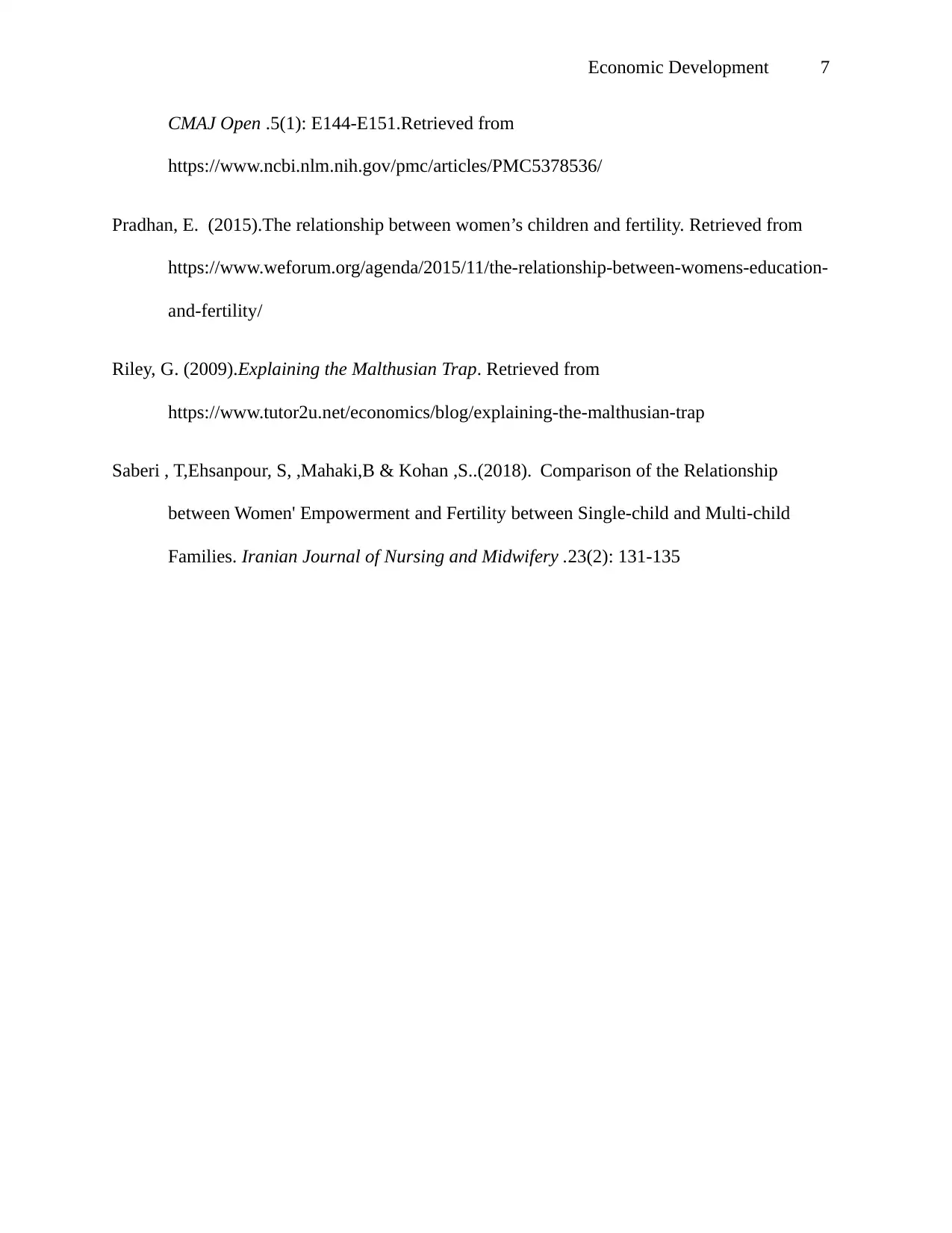
Economic Development 7
CMAJ Open .5(1): E144-E151.Retrieved from
https://www.ncbi.nlm.nih.gov/pmc/articles/PMC5378536/
Pradhan, E. (2015).The relationship between women’s children and fertility. Retrieved from
https://www.weforum.org/agenda/2015/11/the-relationship-between-womens-education-
and-fertility/
Riley, G. (2009).Explaining the Malthusian Trap. Retrieved from
https://www.tutor2u.net/economics/blog/explaining-the-malthusian-trap
Saberi , T,Ehsanpour, S, ,Mahaki,B & Kohan ,S..(2018). Comparison of the Relationship
between Women' Empowerment and Fertility between Single-child and Multi-child
Families. Iranian Journal of Nursing and Midwifery .23(2): 131-135
CMAJ Open .5(1): E144-E151.Retrieved from
https://www.ncbi.nlm.nih.gov/pmc/articles/PMC5378536/
Pradhan, E. (2015).The relationship between women’s children and fertility. Retrieved from
https://www.weforum.org/agenda/2015/11/the-relationship-between-womens-education-
and-fertility/
Riley, G. (2009).Explaining the Malthusian Trap. Retrieved from
https://www.tutor2u.net/economics/blog/explaining-the-malthusian-trap
Saberi , T,Ehsanpour, S, ,Mahaki,B & Kohan ,S..(2018). Comparison of the Relationship
between Women' Empowerment and Fertility between Single-child and Multi-child
Families. Iranian Journal of Nursing and Midwifery .23(2): 131-135
1 out of 8
Your All-in-One AI-Powered Toolkit for Academic Success.
+13062052269
info@desklib.com
Available 24*7 on WhatsApp / Email
![[object Object]](/_next/static/media/star-bottom.7253800d.svg)
Unlock your academic potential
© 2024 | Zucol Services PVT LTD | All rights reserved.

